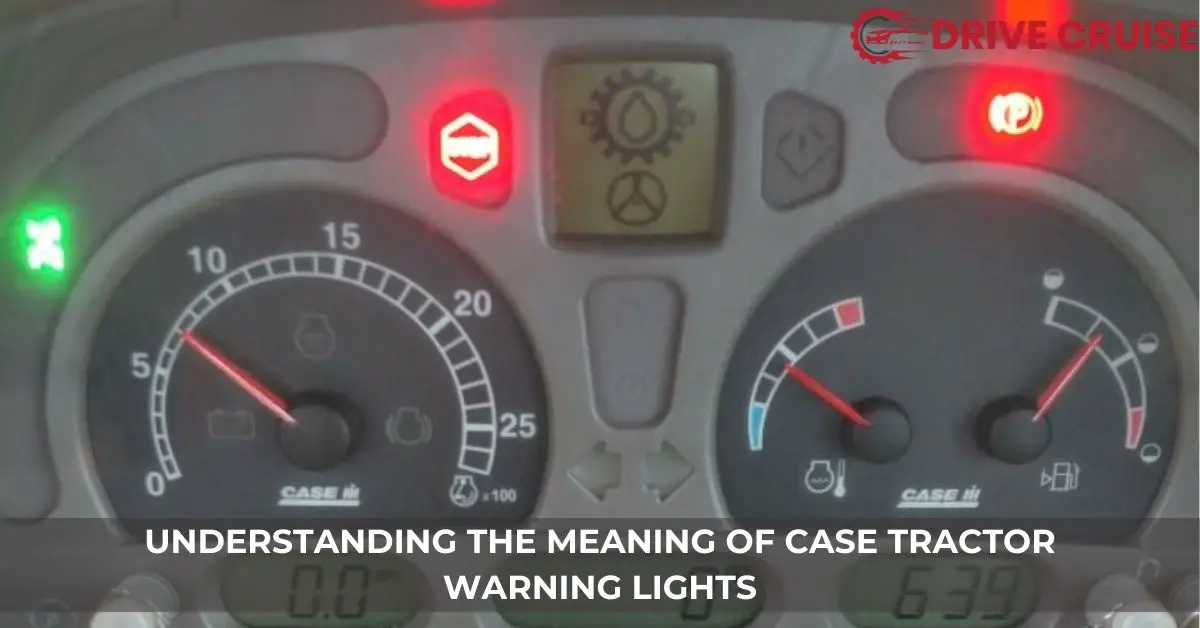Deciphering Key Warning Lights on Your Case Tractor
- Engine Warning Light: When this light illuminates, it indicates a potential issue with the tractor’s engine. It could hint at overheating, low oil pressure, or a need for engine service. Prompt action prevents major engine damage.
- Temperature Warning Light: This symbol suggests the engine or hydraulic fluid temperature is higher than normal. Cooling down the tractor before continuing work is essential to avoid overheating-related damages.
- Oil Pressure Warning Light: A light indicating low oil pressure signifies the lubrication system isn’t working optimally. Checking the oil level and pressure is crucial to ensure the engine’s proper functioning.
- Battery Charge Warning Light: Should this light come on, it indicates the battery isn’t charging correctly. It could point towards alternator issues or battery failure, requiring timely inspection and repair.
- Hydraulic Pressure Warning Light: This light signals problems with the hydraulic system pressure. Maintaining hydraulic systems in good condition is vital for the tractor’s operational capability.
- Brake System Warning Light: If this symbol is lit, it may indicate a malfunction in the braking system. Ensuring brakes are fully functional is critical for safe tractor operation.
- Seat Belt Reminder Light: Serving as a nudge for safety, this light reminds operators to buckle up before starting the tractor.
- Maintenance Reminder Light: This symbol serves as a prompt for scheduled maintenance, ensuring that tractor upkeep isn’t overlooked.
Tips for Maintaining Your Case Tractor
Maintaining your Case tractor not only ensures safety and efficiency but also extends the life of your investment. After understanding the warning lights on the dashboard, it’s crucial to follow through with regular maintenance practices. Here, we’ll share some valuable tips to keep your Case tractor running smoothly.
Regular Check-ups
- Monitor Fluid Levels: Checking and topping up the engine oil, coolant, hydraulic fluid, and transmission fluid are critical to prevent overheating and mechanical wear.
- Inspect Filters: Clean or replace air, fuel, and oil filters regularly to ensure optimal performance and prevent contaminants from damaging the engine.
Preventive Maintenance
- Follow the Maintenance Schedule: Adhere to the manufacturer’s recommended maintenance schedule, which outlines when to perform essential tasks such as changing the oil or inspecting the brakes.
- Check the Tyres: Regularly inspect the tyres for wear and tear, proper inflation, and signs of damage to maintain traction and fuel efficiency.
Seasonal Care
- Prepare for Winter: If operating in cold climates, use winter-grade fuel and engine oil. Consider installing engine block heaters to ease cold starts.
- Cool Down Before Shutdown: Especially in hot weather, allow the tractor to idle and cool down before turning it off to avoid heat build-up and potential engine damage.
- Respond to Alerts: When a warning light illuminates, refer to the tractor’s manual to understand the specific issue and act accordingly. Ignoring these alerts can lead to major damages and costly repairs.
Safety Measures When Operating Your Tractor
Following the discussion on the significance of understanding and responding to warning lights on your Case tractor, it’s crucial to emphasize the safety measures that ensure the operator’s well-being and the machinery’s longevity. Safety is paramount when handling such powerful equipment, and adhering to these guidelines can mitigate risks associated with tractor operations.
Wear Proper Attire
Before even starting the tractor, make sure you’re dressed appropriately. Sturdy boots and tight-fitting clothing that won’t get caught in machinery parts are essentials. Protective gear, including gloves and eye protection, further reduces the risk of injuries.
Conduct Pre-Operational Checks
Always perform a thorough pre-operational inspection of the tractor. Check fluid levels, tire pressure, and the condition of important components. Ensuring everything is in working order before operating the tractor can prevent accidents caused by mechanical failures.
Understand Your Tractor’s Operations
Familiarize yourself with all the controls and the meaning of the dashboard indicators, including the warning lights discussed earlier. Knowing how to respond to these alerts in real time is crucial for preventing accidents and damage to the tractor.
Maintain a Clear Work Area
Ensure your working area is clear of bystanders and obstructions. Awareness of your surroundings is key to avoiding accidents, especially when maneuvering or operating equipment near others.
Use Seat Belts and ROPS
Always use your seat belt, especially in tractors equipped with a Rollover Protection Structure (ROPS). These safety features are designed to protect you in case of an overturn, which is among the leading causes of tractor-related injuries.
Avoid Overloading
Do not overload the tractor or its attachments beyond the recommended capacity. Overloading can cause tip-overs or loss of control, leading to potential injuries and damage to the tractor.
Related Posts:

